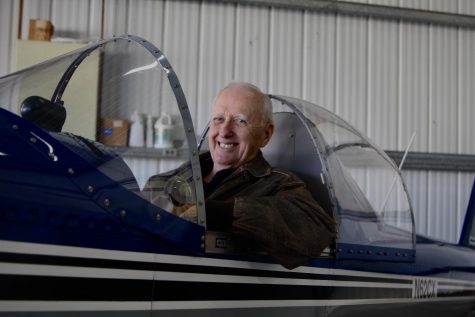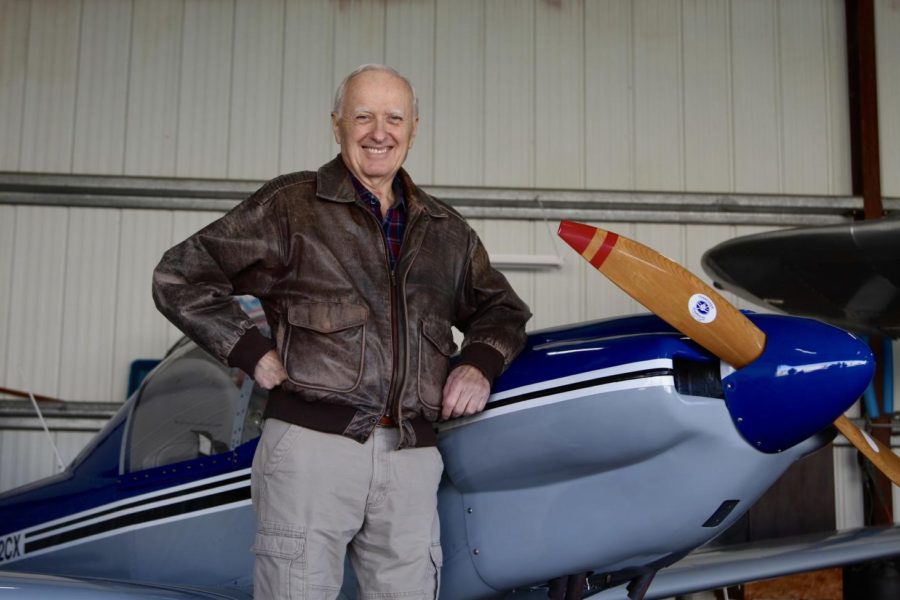“It ain’t bragging if you can do it.”
This is one of the many encouraging notes hanging in Kirkwood resident Dennis Kelly’s basement, carefully handwritten by his wife. The “it” in this case is building and flying his own airplane. Kelly built the Thatcher CX4, a small airplane designed by David Thatcher, in his workshop in the basement of his house.
“[My wife and I] drove down to Pensacola, FL to see his airplane, and I fell in love with it immediately,” Kelly said. “So we bought the plans and the manual, and we drove back home and I started building that airplane. Two years later, I went to the airport with it and started flying it. It first flew in 2009. I’ve been flying and tinkering with it ever since, tweaking it a little bit here and there. It’s really a beautiful, neat airplane.”
We bought the plans and the manual, and I started building that airplane. Two years later, I went to the airport and started flying it.
— Dennis Kelly
Kelly’s interest in aviation began long ago, when he was drafted into the Air Force in the 1960s. After working as a jet engine mechanic in the military, Kelly graduated from the University of Texas and began working for McDonnell Aircraft, an aviation company now owned by Boeing. Kelly shared his first aircraft, a 1947 Cessna 140, with a friend and earned his pilot’s license. After that, Kelly bought a 1946 Cessna 120, which he owned and flew for 27 years. Kelly first attempted to build an aircraft called a Mustang II 20 years ago, which he abandoned due to cost and complexity. The Thatcher CX4 was more practical for Kelly in many ways.
“It was a much simpler design than the first plane I started and a lot less expensive,” Kelly said. “This airplane doesn’t have an aviation engine in it, it has a little Volkswagen Beetle engine. An aircraft engine is $35,000-45,000. This thing is $4,000. I spent a total of about $16,300 on [the CX4]. To finish that other plane, it would’ve cost me at least $50,000.”
After getting the engine, sheet metal and other parts for the airplane, Kelly set to work. He constructed the fuselage, tail and both wings of the aircraft on a workbench in his basement. Kelly occasionally received help from his wife Trinity, who held down the pieces while Dennis riveted them together. When Trinity wasn’t helping Dennis assemble the plane, she was upstairs working in her calligraphy studio, which Dennis said is conveniently far away from his plane workshop.
“It was no problem,” Trinity said. “It was Dennis enjoying what he was doing and I just stayed out of the way when it was something heavy. I was doing my thing in my studio while he was down there riveting away. If he needed a helping hand to hold something down, I was there.”

Dennis finished the individual pieces of the airplane and moved them to his garage to coat them with a special type of flexible aviation paint. The toxic paint required Dennis to wear a sealed hazmat suit while painting. Dennis said his neighbors who watched him construct the plane for years found this step of the process particularly entertaining. When the paint was complete, Dennis borrowed two trailers to transport the pieces to Creve Coeur Airport where he assembled the plane.
“The hardest part of building the plane was flying it,” Dennis jokingly said. “It was a little squirrely on the ground. When I first decided to go out and do just a little test liftoff and settle it back down, the darn thing shot off to the right of the runway and lifted right over the soybeans, scared me to death. I darn near put the wing in the ground, but I got it up. I ended up making a beautiful landing, but it took me two weeks to get up enough courage to get back in that airplane. And I have worked on that squirreliness problem over the years and made some design changes to the rudder pedals and brake systems, and that helped it a lot.”
Dennis had to learn the differences in the CX4 compared to the much “sloppier” controls of the Cessnas he was used to flying. After mastering this, Dennis has continued to fly the CX4 at Creve Coeur Airport almost every weekend when the weather is nice. In 2011, Dennis received a call from Tom Hrdlicka, a Missouri resident with no background in aviation who was interested in building a CX4. Hrdlicka had found Dennis’s phone number on the CX4 website, which had Dennis listed as a previous builder of the plane.

“I gave him a call and he couldn’t have been any nicer,” Hrdlicka said. “So I met him at the airport and saw his plane, and he talked to me about building it. I went ahead and bought [the] plans and started building my own plane after that.”
It took Hrdlicka three and a half years to finish his CX4 after working on the aircraft during his free time, similar to Dennis. Hrdlicka said Dennis helped him throughout the building process by answering questions and loaning him specific tools.
“I still talk to [Dennis] today. He is a friend of mine now,” Hrdlicka said. “He was the biggest help. I believe I would’ve completed my plane, but I wouldn’t have done it in three and half years without Dennis’s knowledge and his help. I can’t thank him enough.”
Along with helping Hrdlicka work on his plane, Dennis has continued to tweak and adjust his own CX4 regularly. He plans to continue flying it simply for his enjoyment.
“I never think of an airplane as getting from point A to point B,” Dennis said. “I just get in there to have fun.”
This story was originally published on The Kirkwood Call on January 7, 2022.































![IN THE SPOTLIGHT: Junior Zalie Mann performs “I Love to Cry at Weddings,” an ensemble piece from the fall musical Sweet Charity, to prospective students during the Fine Arts Showcase on Wednesday, Nov. 8. The showcase is a compilation of performances and demonstrations from each fine arts strand offered at McCallum. This show is put on so that prospective students can see if they are interested in joining an academy or major.
Sweet Charity originally ran the weekends of Sept. 28 and Oct. 8, but made a comeback for the Fine Arts Showcase.
“[Being at the front in the spotlight] is my favorite part of the whole dance, so I was super happy to be on stage performing and smiling at the audience,” Mann said.
Mann performed in both the musical theatre performance and dance excerpt “Ethereal,” a contemporary piece choreographed by the new dance director Terrance Carson, in the showcase. With also being a dance ambassador, Mann got to talk about what MAC dance is, her experience and answer any questions the aspiring arts majors and their parents may have.
Caption by Maya Tackett.](https://bestofsno.com/wp-content/uploads/2024/02/53321803427_47cd17fe70_o-1-1200x800.jpg)
![SPREADING THE JOY: Sophomore Chim Becker poses with sophomores Cozbi Sims and Lou Davidson while manning a table at the Hispanic Heritage treat day during lunch of Sept 28. Becker is a part of the students of color alliance, who put together the activity to raise money for their club.
“It [the stand] was really fun because McCallum has a lot of latino kids,” Becker said. “And I think it was nice that I could share the stuff that I usually just have at home with people who have never tried it before.”
Becker recognizes the importance of celebrating Hispanic heritage at Mac.
“I think its important to celebrate,” Becker said. “Because our culture is awesome and super cool, and everybody should be able to learn about other cultures of the world.”
Caption by JoJo Barnard.](https://bestofsno.com/wp-content/uploads/2024/01/53221601352_4127a81c41_o-1200x675.jpg)






